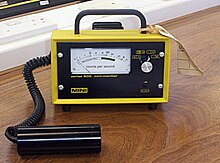Geiger counter

A "two-piece" bench type Geiger–Müller counter with end-window detector
|
|
| Other names | Geiger counter |
|---|---|
| Uses | Particle detector |
| Inventor |
Hans Geiger Walther Müller |
| Related items | Geiger–Müller tube |
The Geiger counter is an instrument used for measuring ionizing radiation used widely in such applications as radiation dosimetry, radiological protection, experimental physics and the nuclear industry.
It detects ionizing radiation such as alpha particles, beta particles and gamma rays using the ionization effect produced in a Geiger–Müller tube; which gives its name to the instrument. In wide and prominent use as a hand-held radiation survey instrument, it is perhaps one of the world's best-known radiation detection instruments.
The original detection principle was discovered in 1908 at the Cavendish laboratory, but it was not until the development of the Geiger-Müller tube in 1928 that the Geiger-Müller counter became a practical instrument. Since then it has been very popular due to its robust sensing element and relatively low cost. However, there are limitations in measuring high radiation rates and the energy of incident radiation.
A Geiger counter consists of a Geiger-Müller tube, the sensing element which detects the radiation, and the processing electronics, which displays the result.
The Geiger-Müller tube is filled with an inert gas such as helium, neon, or argon at low pressure, to which a high voltage is applied. The tube briefly conducts electrical charge when a particle or photon of incident radiation makes the gas conductive by ionization. The ionization is considerably amplified within the tube by the Townsend discharge effect to produce an easily measured detection pulse, which is fed to the processing and display electronics. This large pulse from the tube makes the G-M counter relatively cheap to manufacture, as the subsequent electronics is greatly simplified. The electronics also generates the high voltage, typically 400–600 volts, that has to be applied to the Geiger-Müller tube to enable its operation.
...
Wikipedia
